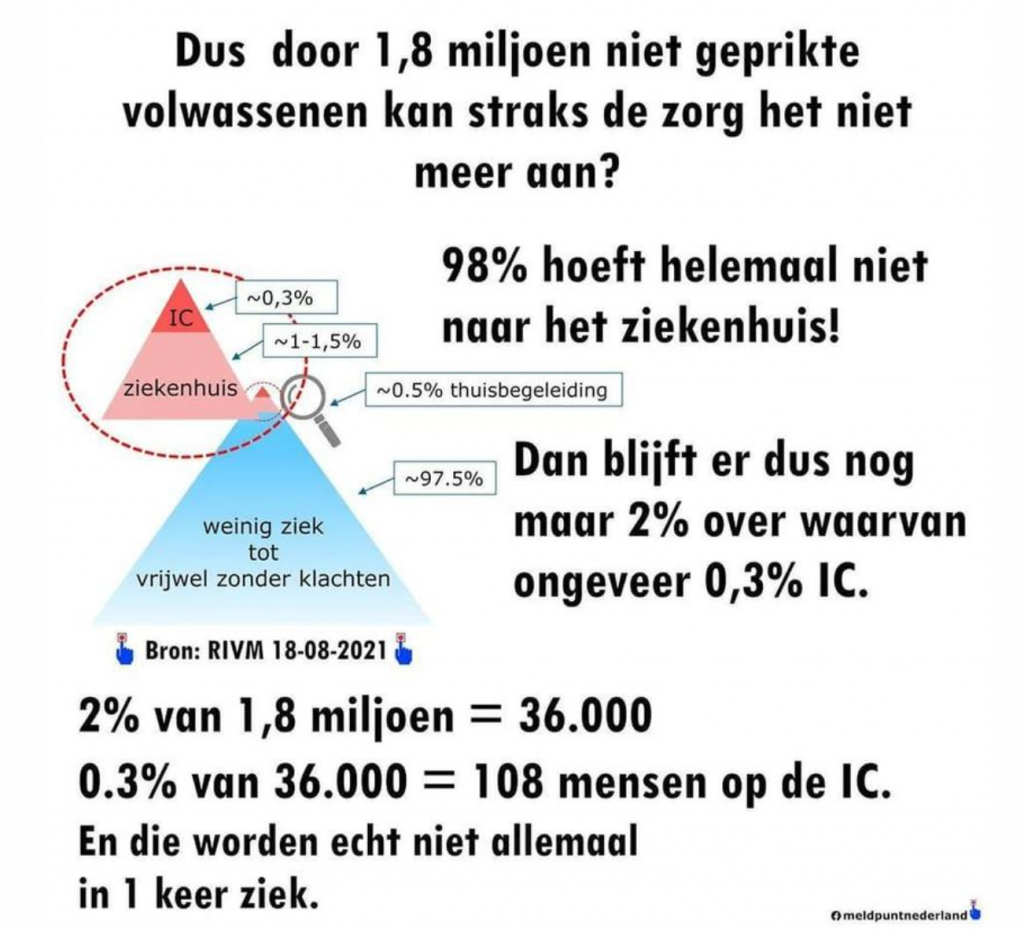This article is a Updated version created
Another persistent calculation error is circulating on social media, hung on the famous Van Dissel's triangle. The big media may be guilty of logical blunders, but wappies can also do something about it. Doctors' collective went wrong before, now it has been FB group Meldpuntnederland. Maybe they have already discovered it, but the picture keeps going around and disinformation has a high viral factor. Enthusiasm creates a bias that allows for the greatest calculation and estimation errors. It's about this picture:

The error
The entire triangle represents 1.8 million people who have yet to come into contact with the virus. The top point is 0.3% of the total triangle and not 0.3% of the 2% that ends up in the hospital. So 0.3% of 1.8 million and not 0.3% of 36,000. So that's 50 times as many: 5,400 ICU people...
Nevertheless: a nonsensical doomsday scenario
There is a lot to be said about that, but not with the objection that is in the triangle. What then:
- Sanquin calculated 93% immunity (and counting, the R is now at 1 and healthcare can handle that). Then 7% of the population is now comprehensible. 7% of 17 million is 1.19 million, not 1.8 million. The assumption is that they will all come into contact with the virus at some point. That too is debatable: there is no evidence that the entire population always comes into contact with every widespread virus.
- The unvaxed are on average young, so hardly cause admissions and ICU, let say 0.2% hospital admissions? That would be about 2,400.
- The vaccines are surrounded by immune people, so that ensures a slow spread, unless the efficacy of the vaccines drops dramatically. Not assuming that, only 30% of the group may be infected per flu season – which is not a strange percentage, looking at previous virus explosions. There is no 100% certainty about this due to instability of the vaccines and possible counterproductive effect with new variants. Per flu season, 750 admissions remain.
- Deliberately Unvaccinated Persons (BOPpers) also know better how to protect themselves effectively: avoid enclosed spaces with strangers, work on a strong immune system. Meet on terraces or otherwise at home, where your air purification is in order. Check your CO2 meter regularly etc. etc. The Netherlands has a rather toxic indoor climate in public spaces due to negligence of public health guards. This health awareness will slow down the spread among that group. Maybe by half or more, but let's say a reduction of one third. That leaves 500 admissions.
Then we already end up with about 500 ICU admissions, spread over the coming flu season of a few months. At the current average admission level of 12 per day, you will be through that in a month and a half. One wonders what the BOPpers can actually be 'blamed' for. Are we now so woke that people are no longer allowed to get sick...?
The scenario could be even more favorable
To counterbalance the doomsday scenarios, we also make some more positive assumptions. For example, the BOPpers are better informed about adequate protection methods. (Are the basic control signs still mentioned since 'ventilation' is added?).
- By paying attention to outside air and ventilation, high, pathogenic doses will rarely occur - if it goes wrong at all. Not only will the number of infections slow down and decrease, as mentioned above. Because I think that it is precisely the false security of the emphasized basic rules that makes many heavy victims, I take another 50% off, and then I am very economical. That leaves 250 admissions per flu season.
- According to the triangle, on average, a quarter of ICU admissions are made. Given the age of the group in question, that will be much, much lower. After all, they have a better recovery capacity, which makes them respond better to hospital treatment. Then there are 100 recordings or even less, to be spread over the season.
What can go wrong
Decreasing the protection of the vaccines would indeed increase the healthcare pressure, both in terms of hospital and ICU admissions.
Apart from the reduction in mortality from Covid-21 described above, also due to mutations, the pressure can also very well become too high due to, for example, flu or other seasonal viruses on which our immune system has long since ceased to be trained. That then becomes a problem because there is hardly any talk of a crisis approach to expand healthcare capacity. Haven't we learned through trial and error? So no: "the measures have helped" and "the predictions all came true." In short: policy adjustments are not necessary, given the successes achieved.
It is surprising that the current continuous excess mortality among the elderly is never mentioned in connection with increased hospital admissions. Pressure on healthcare is apparently the crucial factor for media and politics, not how many people die more than usual.
All things considered, it really doesn't seem possible anymore to shift the blame to the wappies. A 10% higher vaccination rate is not going to make a difference given the target group. No matter how skilfully outgoing Minister De Jonge brings his mission, if things go wrong again, the blame lies entirely with the medical advisors. I could now go on to list all the things they did wrong, but that was not the point now. The point of that triangle has been made.

